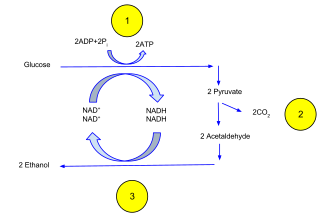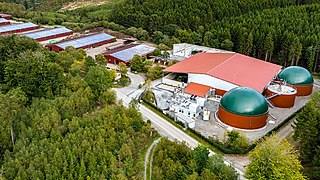Related Research Articles
Fermentation is a metabolic process whereby electrons released from nutrients are ultimately transferred to molecules obtained from the breakdown of those same nutrients.

Cellular respiration is the process by which biological fuels are oxidized in the presence of an inorganic electron acceptor, such as oxygen, to drive the bulk production of adenosine triphosphate (ATP), which contains energy. Cellular respiration may be described as a set of metabolic reactions and processes that take place in the cells of organisms to convert chemical energy from nutrients into ATP, and then release waste products.

An acetate is a salt formed by the combination of acetic acid with a base. "Acetate" also describes the conjugate base or ion typically found in aqueous solution and written with the chemical formula C
2H
3O−
2. The neutral molecules formed by the combination of the acetate ion and a positive ion are also commonly called "acetates". The simplest of these is hydrogen acetate with corresponding salts, esters, and the polyatomic anion CH
3CO−
2, or CH
3COO−
.
Digestion is the breakdown of carbohydrates to yield an energy-rich compound called ATP. The production of ATP is achieved through the oxidation of glucose molecules. In oxidation, the electrons are stripped from a glucose molecule to reduce NAD+ and FAD. NAD+ and FAD possess a high energy potential to drive the production of ATP in the electron transport chain. ATP production occurs in the mitochondria of the cell. There are two methods of producing ATP: aerobic and anaerobic. In aerobic respiration, oxygen is required. Using oxygen increases ATP production from 4 ATP molecules to about 30 ATP molecules. In anaerobic respiration, oxygen is not required. When oxygen is absent, the generation of ATP continues through fermentation. There are two types of fermentation: alcohol fermentation and lactic acid fermentation.
Anaerobic respiration is respiration using electron acceptors other than molecular oxygen (O2). Although oxygen is not the final electron acceptor, the process still uses a respiratory electron transport chain.

Malolactic conversion is a process in winemaking in which tart-tasting malic acid, naturally present in grape must, is converted to softer-tasting lactic acid. Malolactic fermentation is most often performed as a secondary fermentation shortly after the end of the primary fermentation, but can sometimes run concurrently with it. The process is standard for most red wine production and common for some white grape varieties such as Chardonnay, where it can impart a "buttery" flavor from diacetyl, a byproduct of the reaction.

Ethanol fermentation, also called alcoholic fermentation, is a biological process which converts sugars such as glucose, fructose, and sucrose into cellular energy, producing ethanol and carbon dioxide as by-products. Because yeasts perform this conversion in the absence of oxygen, alcoholic fermentation is considered an anaerobic process. It also takes place in some species of fish where it provides energy when oxygen is scarce.

Anaerobic digestion is a sequence of processes by which microorganisms break down biodegradable material in the absence of oxygen. The process is used for industrial or domestic purposes to manage waste or to produce fuels. Much of the fermentation used industrially to produce food and drink products, as well as home fermentation, uses anaerobic digestion.
An acetogen is a microorganism that generates acetate (CH3COO−) as an end product of anaerobic respiration or fermentation. However, this term is usually employed in a narrower sense only to those bacteria and archaea that perform anaerobic respiration and carbon fixation simultaneously through the reductive acetyl coenzyme A (acetyl-CoA) pathway (also known as the Wood-Ljungdahl pathway). These genuine acetogens are also known as "homoacetogens" and they can produce acetyl-CoA (and from that, in most cases, acetate as the end product) from two molecules of carbon dioxide (CO2) and four molecules of molecular hydrogen (H2). This process is known as acetogenesis, and is different from acetate fermentation, although both occur in the absence of molecular oxygen (O2) and produce acetate. Although previously thought that only bacteria are acetogens, some archaea can be considered to be acetogens.
The rumen, also known as a paunch, is the largest stomach compartment in ruminants and the larger part of the reticulorumen, which is the first chamber in the alimentary canal of ruminant animals. The rumen's microbial favoring environment allows it to serve as the primary site for microbial fermentation of ingested feed. The smaller part of the reticulorumen is the reticulum, which is fully continuous with the rumen, but differs from it with regard to the texture of its lining. It covers approximately 80% of total ruminant stomach portion
Acetogenesis is a process through which acetate is produced by prokaryote microorganisms either by the reduction of CO2 or by the reduction of organic acids, rather than by the oxidative breakdown of carbohydrates or ethanol, as with acetic acid bacteria.

In biochemistry, mixed acid fermentation is the metabolic process by which a six-carbon sugar is converted into a complex and variable mixture of acids. It is an anaerobic (non-oxygen-requiring) fermentation reaction that is common in bacteria. It is characteristic for members of the Enterobacteriaceae, a large family of Gram-negative bacteria that includes E. coli.
Microbial metabolism is the means by which a microbe obtains the energy and nutrients it needs to live and reproduce. Microbes use many different types of metabolic strategies and species can often be differentiated from each other based on metabolic characteristics. The specific metabolic properties of a microbe are the major factors in determining that microbe's ecological niche, and often allow for that microbe to be useful in industrial processes or responsible for biogeochemical cycles.

The bioconversion of biomass to mixed alcohol fuels can be accomplished using the MixAlco process. Through bioconversion of biomass to a mixed alcohol fuel, more energy from the biomass will end up as liquid fuels than in converting biomass to ethanol by yeast fermentation.
In biology, syntrophy, syntrophism, or cross-feeding is the cooperative interaction between at least two microbial species to degrade a single substrate. This type of biological interaction typically involves the transfer of one or more metabolic intermediates between two or more metabolically diverse microbial species living in close proximity to each other. Thus, syntrophy can be considered an obligatory interdependency and a mutualistic metabolism between different microbial species, wherein the growth of one partner depends on the nutrients, growth factors, or substrates provided by the other(s).

Fermentation is a metabolic process that produces chemical changes in organic substances through the action of enzymes. In biochemistry, fermentation is narrowly defined as the extraction of energy from carbohydrates in the absence of oxygen, while in food production, it may more broadly refer to any process in which the activity of microorganisms brings about a desirable change to a foodstuff or beverage. The science of fermentation is known as zymology.

Digestate is the material remaining after the anaerobic digestion of a biodegradable feedstock. Anaerobic digestion produces two main products: digestate and biogas. Digestate is produced both by acidogenesis and methanogenesis and each has different characteristics. These characteristics stem from the original feedstock source as well as the processes themselves.
Fermentative hydrogen production is the fermentative conversion of organic substrates to H2. Hydrogen produced in this manner is often called biohydrogen. The conversion is effected by bacteria and protozoa, which employ enzymes. Fermentative hydrogen production is one of several anaerobic conversions.
Acetobacterium is a genus of anaerobic, Gram-positive bacteria that belong to the Eubacteriaceae family. The type species of this genus is Acetobacterium woodii. The name, Acetobacterium, has originated because they are acetogens, predominantly making acetic acid as a byproduct of anaerobic metabolism. Most of the species reported in this genus are homoacetogens, i.e. solely producing acetic acid as their metabolic byproduct. They should not be confused with acetic acid bacteria which are aerobic, Gram-negative Alphaproteobacteria.
Methanogens are a group of microorganisms that produce methane as a byproduct of their metabolism. They play an important role in the digestive system of ruminants. The digestive tract of ruminants contains four major parts: rumen, reticulum, omasum and abomasum. The food with saliva first passes to the rumen for breaking into smaller particles and then moves to the reticulum, where the food is broken into further smaller particles. Any indigestible particles are sent back to the rumen for rechewing. The majority of anaerobic microbes assisting the cellulose breakdown occupy the rumen and initiate the fermentation process. The animal absorbs the fatty acids, vitamins and nutrient content on passing the partially digested food from the rumen to the omasum. This decreases the pH level and initiates the release of enzymes for further breakdown of the food which later passes to the abomasum to absorb remaining nutrients before excretion. This process takes about 9–12 hours.
References
- ↑ Marchaim, U. (1992). FAO Agricultural Services Bulletin – 95: Biogas process for sustainable development, FAO – Food and Agriculture Organization of the United Nations, ISSN 1010-1365 (1/9/2003).
- ↑ Alexiou, I.E. and Panter, K. (2004). A review of two phase applications to define best practice for the treatment of various waste streams. Anaerobic Digestion 10th World Congress, September 2004. Montreal, Quebec, Canada.
- ↑ (in Spanish) Cairó, J.J. and París, J.M. (1988). Microbiología de la digestión anaerobia, metanogénesis. 4o Seminario de Depuración Anaerobia de Aguas Residuales. Valladolid. F.F. Polanco, P.A. García y S. Hernándo. (Eds.) pp. 41–51.
- ↑ Dinopolou, G., Rudd, T. and Lester, J.N. (1987). Anaerobic acidogenesis of a complex wastewater: I. The influence of operational parameters on reactor performance. Biotech. And Bioeng. 31: 958 – 968.
- ↑ (in French) Laroche, M. (1983). Metabolisme intermediaire des acides gras volatils en fermentation methanique. These de Docteur – Ingenieur en Sciences Alimentaires_Fermentations. Institut National de la Recherche Agronomique, France.
- ↑ Winter, J.U. and Wolfe, R.S. (1979). Complete degradation of carbohydrates to CO2 and methane by syntrophic cultures of Acetobacterium woodii y Methanosarcina barkeri. Arch. Microbiol. 121: 97 – 102.